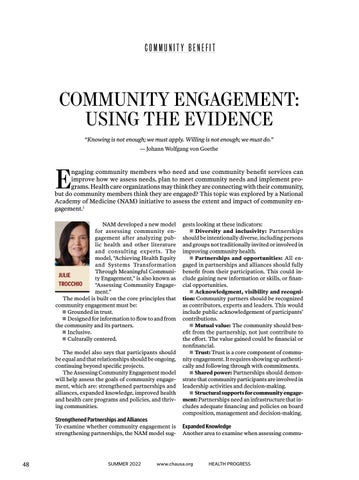COMMUNITY BENEFIT
COMMUNITY ENGAGEMENT: USING THE EVIDENCE “Knowing is not enough; we must apply. Willing is not enough; we must do.” — Johann Wolfgang von Goethe
E
ngaging community members who need and use community benefit services can improve how we assess needs, plan to meet community needs and implement programs. Health care organizations may think they are connecting with their community, but do community members think they are engaged? This topic was explored by a National Academy of Medicine (NAM) initiative to assess the extent and impact of community engagement.1 NAM developed a new model for assessing community engagement after analyzing public health and other literature and consulting experts. The model, “Achieving Health Equity and Systems Transformation Through Meaningful CommuniJULIE ty Engagement,” is also known as TROCCHIO “Assessing Community Engagement.” The model is built on the core principles that community engagement must be: Grounded in trust. Designed for information to flow to and from the community and its partners. Inclusive. Culturally centered. The model also says that participants should be equal and that relationships should be ongoing, continuing beyond specific projects. The Assessing Community Engagement model will help assess the goals of community engagement, which are: strengthened partnerships and alliances, expanded knowledge, improved health and health care programs and policies, and thriving communities.
Strengthened Partnerships and Alliances
To examine whether community engagement is strengthening partnerships, the NAM model sug-
48
SUMMER 2022
gests looking at these indicators: Diversity and inclusivity: Partnerships should be intentionally diverse, including persons and groups not traditionally invited or involved in improving community health. Partnerships and opportunities: All engaged in partnerships and alliances should fully benefit from their participation. This could include gaining new information or skills, or financial opportunities. Acknowledgment, visibility and recognition: Community partners should be recognized
as contributors, experts and leaders. This would include public acknowledgement of participants’ contributions. Mutual value: The community should benefit from the partnership, not just contribute to the effort. The value gained could be financial or nonfinancial. Trust: Trust is a core component of community engagement. It requires showing up authentically and following through with commitments. Shared power: Partnerships should demonstrate that community participants are involved in leadership activities and decision-making. Structural supports for community engagement: Partnerships need an infrastructure that in-
cludes adequate financing and policies on board composition, management and decision-making.
Expanded Knowledge
Another area to examine when assessing commu-
www.chausa.org
HEALTH PROGRESS
